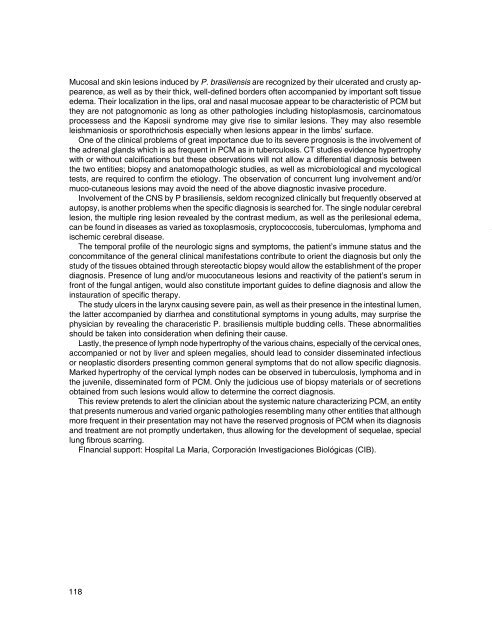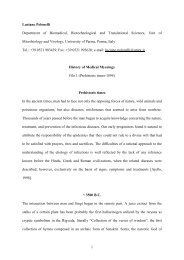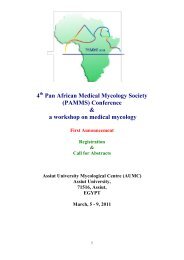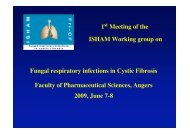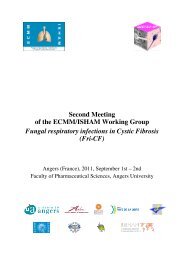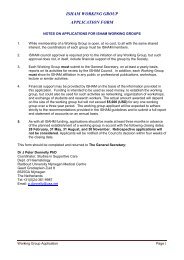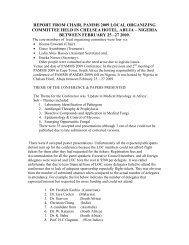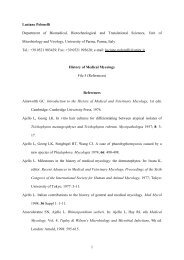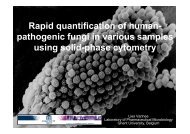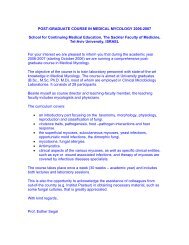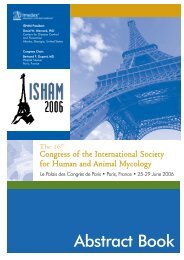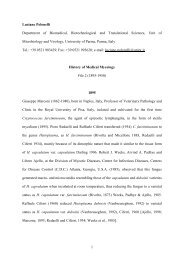Memoria CD.indd - ISHAM
Memoria CD.indd - ISHAM
Memoria CD.indd - ISHAM
Create successful ePaper yourself
Turn your PDF publications into a flip-book with our unique Google optimized e-Paper software.
Mucosal and skin lesions induced by P. brasiliensis are recognized by their ulcerated and crusty appearence,as well as by their thick, well-defined borders often accompanied by important soft tissueedema. Their localization in the lips, oral and nasal mucosae appear to be characteristic of PCM butthey are not patognomonic as long as other pathologies including histoplasmosis, carcinomatousprocessess and the Kaposii syndrome may give rise to similar lesions. They may also resembleleishmaniosis or sporothrichosis especially when lesions appear in the limbs’ surface.One of the clinical problems of great importance due to its severe prognosis is the involvement ofthe adrenal glands which is as frequent in PCM as in tuberculosis. CT studies evidence hypertrophywith or without calcifications but these observations will not allow a differential diagnosis betweenthe two entities; biopsy and anatomopathologic studies, as well as microbiological and mycologicaltests, are required to confirm the etiology. The observation of concurrent lung involvement and/ormuco-cutaneous lesions may avoid the need of the above diagnostic invasive procedure.Involvement of the CNS by P brasiliensis, seldom recognized clinically but frequently observed atautopsy, is another problems when the specific diagnosis is searched for. The single nodular cerebrallesion, the multiple ring lesion revealed by the contrast medium, as well as the perilesional edema,can be found in diseases as varied as toxoplasmosis, cryptococcosis, tuberculomas, lymphoma andischemic cerebral disease.The temporal profile of the neurologic signs and symptoms, the patient’s immune status and theconcommitance of the general clinical manifestations contribute to orient the diagnosis but only thestudy of the tissues obtained through stereotactic biopsy would allow the establishment of the properdiagnosis. Presence of lung and/or mucocutaneous lesions and reactivity of the patient’s serum infront of the fungal antigen, would also constitute important guides to define diagnosis and allow theinstauration of specific therapy.The study ulcers in the larynx causing severe pain, as well as their presence in the intestinal lumen,the latter accompanied by diarrhea and constitutional symptoms in young adults, may surprise thephysician by revealing the characeristic P. brasiliensis multiple budding cells. These abnormalitiesshould be taken into consideration when defining their cause.Lastly, the presence of lymph node hypertrophy of the various chains, especially of the cervical ones,accompanied or not by liver and spleen megalies, should lead to consider disseminated infectiousor neoplastic disorders presenting common general symptoms that do not allow specific diagnosis.Marked hypertrophy of the cervical lymph nodes can be observed in tuberculosis, lymphoma and inthe juvenile, disseminated form of PCM. Only the judicious use of biopsy materials or of secretionsobtained from such lesions would allow to determine the correct diagnosis.This review pretends to alert the clinician about the systemic nature characterizing PCM, an entitythat presents numerous and varied organic pathologies resembling many other entities that althoughmore frequent in their presentation may not have the reserved prognosis of PCM when its diagnosisand treatment are not promptly undertaken, thus allowing for the development of sequelae, speciallung fibrous scarring.FInancial support: Hospital La Maria, Corporación Investigaciones Biológicas (CIB).118


